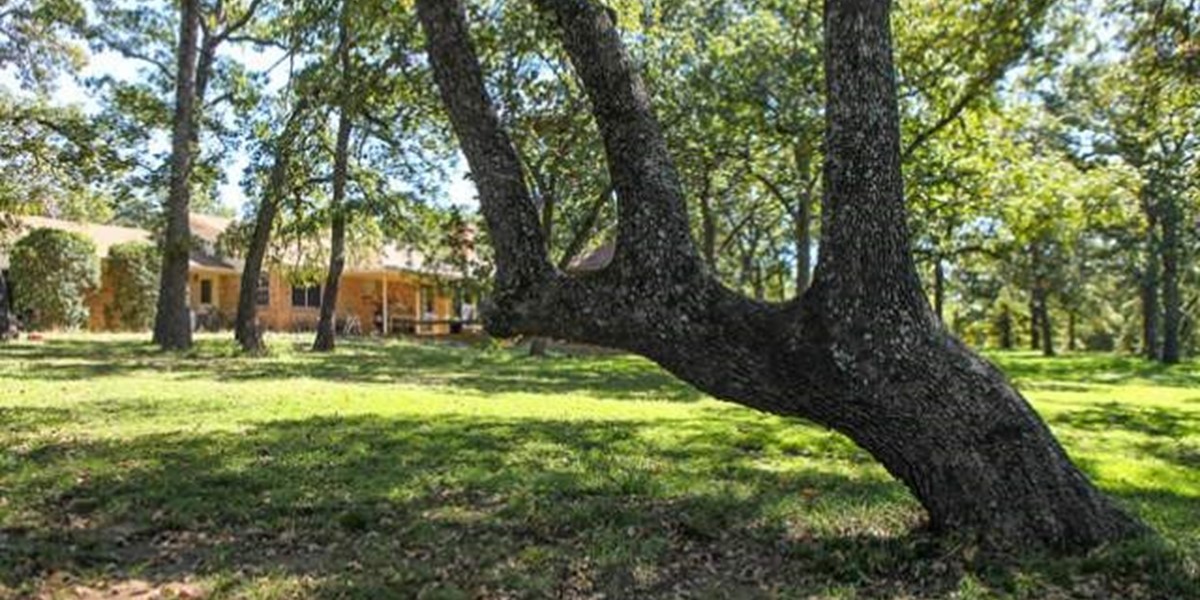

Published October 29, 2014 By MICHAEL HUTCHINS
GORDONVILLE — At first glance the oddly shaped tree in Brad Ward’s yard simply appears to be an old, misshapen tree. The post oak curves at its base, running nearly parallel to the ground, with three thick branches sticking up in to the air, away from the main trunk. The unusual shape of it makes it stand out among the other trees in Ward’s yard — precisely what you would want for something meant to mark a trail, over 100 years ago.
Recently, officials with the Comanche Nation, in a joint effort with the Texas Historic Trees Coalition, certified the tree as a Comanche trail tree. The trail trees were used to mark locations of significance, ranging from campsites, and sources of water, to locations of historic and cultural significance, to the native people of this region. Currently, there are three trees that bear such recognition along the Red River Valley — two in Grayson County, and one near Wichita Falls.
“I always felt there was something different about that tree,” said Ward, who said his wife’s family has lived on the land for over a century. For over 65 years, Ward said he was unaware of the history behind the tree, but felt there was something special about it.
When Ward, a resident of Gordonville, was younger he would always hear stories from his father-in-law about times when he was a child and Native American families would come and ask to camp near to the tree.
It wasn’t until about five years ago that Ward found a tree that looked similar to his while he was online one day. Ward said it was an accident, a misspelling of a word, which led him to the picture of the tree. What Ward had found in his search was one of the first trail marker trees to be certified and confirmed in the state of Texas by the Comanche Nation.
“I thought that if they have a trail marker tree then I have a trail marker tree,” said Ward. “I just thought if it was a historic tree it should be marked, taken care of, and people should know about it.”
Carney Saupitty Jr. with the Comanche National Museum and Cultural Center said cultural sites like trail trees are a key part of the Comanche cultural identity. As recent history has brought many tribes together in a small area, the site serves as something that is distinct to the Comanche people who once roamed the Comancheria — the area stretching from Central Texas into New Mexico, Oklahoma, Colorado and Kansas.
Saupitty said the Comanche were nomadic, following trails across the wide stretch of land, making trail markers an important part of the culture. At their height, Saupitty said there were over 40,000 members of the Comanche tribe, so many that the Comanche had a specific word for other Comanche that one did not know.
Steve Houser, an arborist with the Texas Historic Trees Coalition who studied the tree, said he has researched over 300 trees in the state. He has confirmed about seven marker trees in the Dallas area, and maintains a file on about 150 others that may be markers. Houser said the process of confirming trees can be a slow one.
“Nature has many ways to bend a tree,” said Houser, who has over 30 years working with trees and other plant life, “There are many, many bent trees out there that are not marker trees.”
For the past three years, Ward has been working with the Nation and the Coalition to confirm the history behind the tree. One of the difficulties in confirming if a tree was used as a trail marker is confirming the age of the tree, said Houser.
“An archaeologist traditionally would use a drill to bore into the tree and remove samples so they could read the growth rings,” said Houser. “I don’t do that. I don’t feel it is respectful, especially if it is a true Comanche marker tree.”
Houser said he uses techniques to estimate an approximate age of the tree and determine if it would be from the correct time frame — between 159 and 264 years ago.
While looking at dead branches from the tree, Houser said the limbs had about 23 ringers per inch. For Ward’s tree, Houser said the growth rate was slow due to the shape of the tree. Nearby, Houser said he found a tree stump with 26 rings per inch, giving more evidence of the tree’s age.
In addition to the shape and age of the tree, Houser said he noticed scarring and ribs on the bark, and compression marks from where the leather straps may have tied the tree down, giving it the characteristic shape. In addition to these indicators, Houser said he noticed a smooth nose on the bend of the main trunk, another indicator of the tree’s past.
Houser also looked at maps and the history of the site for indicators of the tree’s history. Houser and delegates from the Nation examined arrowheads and other artifacts Ward found near the site. The tree was also pointing in the direction of a low water crossing of the Red River, and there are signs of a natural spring at the site, said Houser.
A nearby tree, which has been confirmed to be a Comanche trail tree, was also on the site of a natural spring, said Houser.
The recent interest in trail trees started when the Comanche Nation recognized the first tree in Texas when it confirmed a tree in Dallas in the mid-1990s. Further interest in North Texas started after a newspaper article was published, detailing a tree in Holiday, Texas that was also recognized by the Nation.
“It took one tree to be recognized in a story for everyone to start looking for them,” said Houser.
